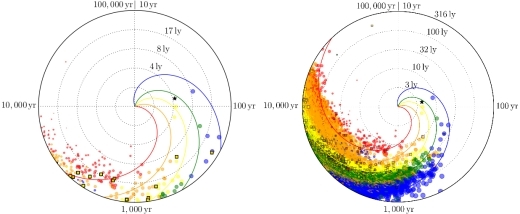Paul Gilster's Blog, page 131
April 18, 2017
Mission Concepts: Bound Orbits around Other Stars
Can we use a laser array to get a fast probe to another star? Breakthrough Starshot relies upon the notion, which was first advanced by Robert Forward all the way back in 1962, and subsequently considered by George Marx in 1966, along with hosts of researchers since. With beamed energy we leave the propellant behind, but as we’ve seen in our discussions of deceleration, there remains the problem of slowing down at the target. Breakthrough Starshot assumes a flyby, but the paper we looked at yesterday works out strategies for braking into orbit at the target star. Or more accurately, at the target stars, for multiple systems are assumed.
Let’s dig back into that paper today, but first, let me make a brief administrative comment. The upcoming Breakthrough Discuss meeting in Palo Alto (I covered last year’s sessions) occurs at exactly the wrong time for me — I’m locked into long-standing travel plans elsewhere. While I travel, there will be no Centauri Dreams posts for the rest of this week, though I will try to keep up with comment moderation. Things return to normal next Monday.
Now, as to multiple stars and our target list. René Heller, Michael Hippke and Pierre Kervella use multiple stars as ‘photon bumpers,’ depending upon steep deceleration at one or more in order to slow the craft and deflect it on to a final target. Alpha Centauri is the obvious case in point, for using these methods we can consider a probe that brakes into orbit around Proxima b after decelerating encounters with Centauri A and B. The new paper revises a January paper from Heller and Hippke by offering trajectories that provide for faster cruise times.
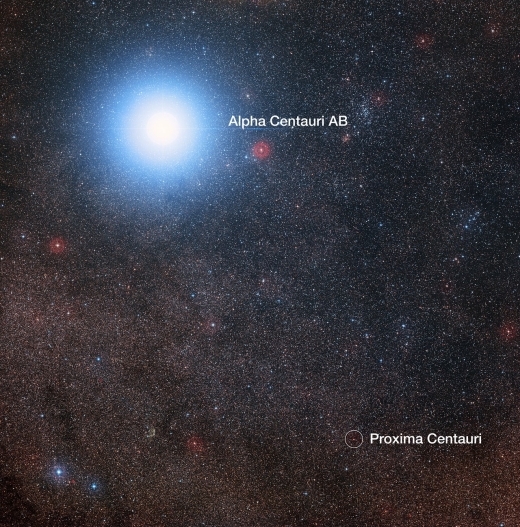
Image: This image of the sky around the binary Alpha Centauri AB also shows the much fainter red dwarf star, Proxima Centauri, the closest star to the Solar System. The picture was created from images forming part of the Digitized Sky Survey 2. Credit: Digitized Sky Survey 2. Acknowledgement: Davide De Martin/Mahdi Zamani.
Interstellar Destinations
As we saw yesterday, the authors believe they can cut the travel time to Centauri A and B from 95 to 75 years (with an additional 46 years necessary for the crossing to Proxima Centauri). All this depends upon maximizing the arrival speed at the first star while producing enough deceleration through photon braking to make the needed speed and course adjustments. And if this can be done at Alpha Centauri, it can be done with other nearby systems, but we would experience much longer travel times with single stars like Tau Ceti or Epsilon Eridani.
Fortunately, multiple star systems abound, offering interesting possibilities. Having optimized the trajectories for Proxima Centauri, the authors consider Sirius A, which is actually about twice the distance from the Sun as Alpha Centauri. The star is bright enough (24.2 solar luminosities) that maximum insertion speed into the Sirius system can be high, some 12.5% of the speed of light. We get a much faster cruise speed coupled with much more dramatic deceleration, and the travel time of 69 years is actually shorter than our Proxima mission.
Sirius is itself a binary, with a white dwarf, Sirius B, that would be useful to study. The paper’s Table 2 is worth reproducing here, as it broadens the range of targets still further.
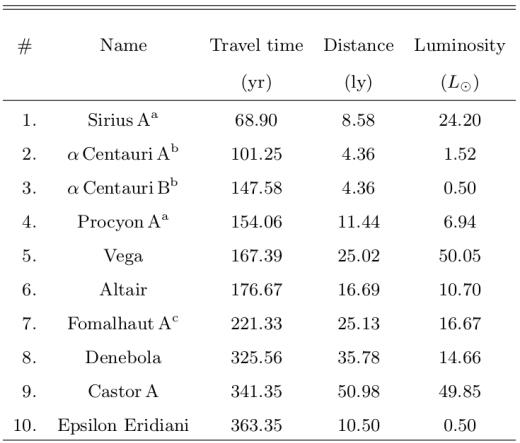
Image: The paper’s Table 2. Caption: An interstellar travel catalog to use photogravitational assists for a full stop. Credit: Heller, Hippke and Kervella.
Notice that Epsilon Eridani is 10.5 light years away, while Sirius A is 8.58 light years distant, but the journey to Epsilon Eridani is a whopping 363 years compared to the 68.9 to Sirius. Here again we’re relying on the innate brightness of Sirius to allow the fast insertion speed that will accommodate maximum cruise velocity plus deceleration and trajectory change at destination — we don’t have this at Epsilon Eridani. But that also presupposes that we have the ability to launch a craft at a blistering 12.5 percent of c. Breakthrough Starshot talks about 20% of c through the use of an Earth-based laser array. For their part, Heller, Hippke and Kervella think a hybrid accelerative boost might be the best approach:
A graphene-class sail could have a maximum ejection speed of about 11,500 km s −1 from the solar system if it was possible to bring it as close as five solar radii to the Sun and then initiate a photogravitational launch (Heller & Hippke 2017). This is much less than the maximum injection speed of 17,050 km s −1 that can be absorbed by successive photogravitational assists at α Cen A to C. If sunlight were to be used to push a lightsail away from the solar system, then its propulsion would need to be supported by a second energy source, e.g. a ground-based laser array, to fully exploit the potential of photogravitational deceleration upon arrival. A combination with sunlight might in fact reduce the huge energy demands of a ground-based laser system.
Lessening the requirements for the array is all to the good considering the challenge of building it and powering it up. Of course, the hybrid approach assumes huge advances in sail materials, though the authors believe that current progress with graphene will make a workable sail for these purposes feasible within the next few decades. However we reach the necessary speeds, we can look at the prospect of even faster speeds with the assistance of other stars.
The Sirius Afterburner
Which gets us back to Sirius, where the authors consider what they call the ‘Sirius afterburner,’ in which the star becomes the instrument for achieving higher speeds than we can achieve with Earth-based technologies. The authors’ numerical simulations show that minimizing deceleration during approach while maximizing the acceleration after the flyby can increase the velocity of the lightsail up to 27,000 km s-1. That’s a boost of 9 percent of the speed of light. Sirius, then, with its proximity to the Sun and its brightness, becomes what the paper calls “the most natural choice for an interstellar photogravitational hub for humanity.”
Taking that broad view of a possible future is what the paper’s next figure is all about.
Image: Travel times (as hour angles) versus stellar distance to the solar system (along the radial coordinate) for stars in the solar neighborhood. Symbols refer to numerical trajectory simulations to individual targets, lines refer to the logarithmic spiral derived in Equation (4). The spirals are parameterized using M2V (red), K5V (orange), G2V (yellow), F3V (green), and A0V (blue) template stars from Pecaut & Mamajek (2013). Square symbols represent stars with known exoplanets. The black star symbol represents α Cen. Left: All 117 stars within 21 ly around the Sun. Right: 22,178 stars out to 316 ly around the Sun. Credit: Heller, Hippke & Kervella.
A photogravitational hub like this can yield an interesting target list indeed. We have a total of 328 known exoplanet host stars within 316 light years, and many stars of astrophysical interest in themselves. Among these, the authors suggest such destinations as TV Crateris, which is a quadruple system of young T Tauri stars about 150 light years away. 36 Ophiuchi is a triple system of K stars some 19.5 light years out. Also intriguing: Fomalhaut, 25 light years away and another triple, with exoplanet Fomalhaut b and protoplanetary disks around Fomalhaut A (Alpha Piscis Austrini) and C (LP 876-10).
We would like to reach any number of single star targets as well, especially nearby red dwarfs of the sort that we will soon be analyzing for biosignatures, but achieving a bound orbit around such a star would involve extremely long travel times. A flyby more like the basic Breakthrough Starshot concept seems to make more sense for these because unlike Proxima Centauri, they have no nearby bright stars to slow the incoming craft and alter its trajectory.
The paper is sanguine about the prospects for developing the needed technologies for the missions examined herein. Components currently under development include:
…procedures for the large-scale production of graphene sheets, nanowires with the necessary electronic properties consisting of single carbon atom layers, gram-scale cameras and lasers (for communication between the sail and Earth), or sub-gram-scale computer chips required to perform on-board processing etc. We thus expect that a concerted effort of electronic, nano-scale, and space industries and research consortia could permit the construction and launch of ultra-light photon sails capable of interstellar travels and photogravitational assists, e.g. to Proxima b, within the next few decades.
Making any of these missions happen, though, demands the highest degree of aiming accuracy, which we lack even for the Alpha Centauri stars (and bear in mind that Gaia will not observe Centauri A or B). To pull off a successful ‘bank shot’ in the Centauri system, we will have to nail the proper motion and binary orbital motion of the AB binary. Right now our data are simply not sufficient: The authors note that we lack the current capability to achieve orbital injection and swing-by to Proxima, something that will have to be remedied through highly precise astrometry.
The paper is Heller, Hippke and Kervella, “Optimized trajectories to the nearest stars using lightweight high-velocity photon sails” (preprint).






April 17, 2017
Proxima Mission: Fine-Tuning the Photogravitational Assist
Deceleration has always been problematic in projected schemes for interstellar travel. A flyby of a star at a substantial percentage of lightspeed yields a fraction of the data that would be obtainable by a probe slowed into orbit in the target system. But how to slow down? In particular, how do you slow down when your method of propulsion is beamed energy?
The ideas have flowed over the years, ranging from Philip Norem’s ‘thrustless turning’ — using interactions between the spacecraft and the interstellar magnetic field — to Robert Forward’s ‘staged’ sail, in which the sail separates into separate components, with beamed laser light from Earth bouncing off one to the other to slow the payload. Norem’s notion, though, hugely lengthened trip times while taking the spacecraft far beyond the target before turning it back, while staged sails require a pointing accuracy in a laser array that is hard to imagine.
Many other options have been advanced, including braking against a stellar wind with a magsail, but it was a recent paper from René Heller (Max Planck Institute for Solar System Research, Göttingen) and German colleague Michael Hippke that got my attention at the beginning of February (see By ‘Photogravitational Assists’ to Proxima b). Heller and Hippke are now joined by Pierre Kervella (CNRS/Universidad de Chile) in a reworking of the original idea with a major twist, a far more effective means of slowing and turning the craft which, in turn, produces much faster travel times because it allows a higher speed upon arrival.
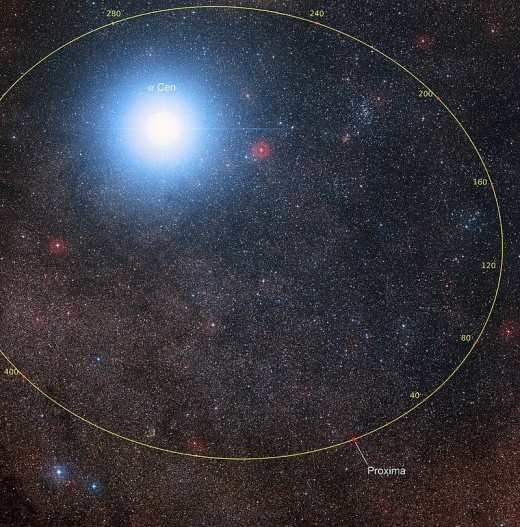
Image: Orbital plot of Proxima Centauri showing its position with respect to Alpha Centauri over the coming millennia (graduations are in thousands of years). The large number of background stars is due to the fact that Proxima Cen is located very close to the plane of the Milky Way. Credit: P. Kervella (CNRS/U. of Chile/Observatoire de Paris/LESIA), ESO/Digitized Sky Survey 2, D. De Martin/M. Zamani -https://www.eso.org/public/images/ann16089a/
Photogravitational Assists and Lightsails
The original Heller/Hippke paper fit nicely with the Breakthrough Starshot idea, in that what the latter was proposing was to accelerate small beamed sails up to 20 percent of the speed of light for a flyby of the Proxima Centauri system and its interesting planet Proxima b. Hippke and Heller advocated using the G-class Centauri A and K-class Centauri B as ‘photon bumpers,’ with a much larger lightsail than Breakthrough Starshot envisioned being slowed and having its trajectory altered by photon pressure and gravity, with a final deflection to Proxima Centauri itself, which the craft would approach at a speed slow enough for photon braking into orbit.
The new paper finds a more efficient way of using a star as a photon bumper, one that increases the deceleration at Centauri A and B and thus allows the sail to approach these stars faster. The savings are substantial: Using a modified photogravitational assist as suggested here, we cut the travel time from 95 years to 75 years. You can see that to use these methods, a single star is not optimum. We look instead for multiple systems in which we can use two or more stars to pull off this interstellar bank shot. Intriguingly, it turns out that the Alpha Centauri system may not actually be the closest — in time — for such a mission, but more on that later.
The spacecraft that Heller, Hippke and Kervella have in mind is made of an ultralight material like graphene, which would be coated with “a highly reflective broadband coating made of sub-wavelength metamaterials.” For a Centauri mission, the craft would be brought up to cruise velocity by a close solar pass rather than accelerated through a ground-based laser array, the method being investigated by Breakthrough Starshot. The lightsail would be accelerated to a cruise velocity of 4.6 percent of c. It would use the assist maneuver upon arrival at Centauri A and B and brake into Proxima to achieve a bound orbit around Proxima b.
When using the photon pressure of a star and its gravitational pull to both decelerate and deflect an incoming sail, the key is to find the maximum possible injection speed at the first destination star. Doing that at Alpha Centauri A would allow the necessary flyby and course adjustment at Centauri B, followed by deflection to Proxima. Finding that injection speed has to be factored against reaching the required deflection angle between inbound and outbound trajectories.
The new work introduces follow-up studies to the Heller/Hippke paper that tweak the simulations with a revised concept, one that favors stellar photon pressure over gravity in enhancing the deflection. The result: “we demonstrate that such a photogravitational assist is more effective when the star is used as a bumper (i.e. the sail passes “in front of” the star) rather than as a catapult (i.e. the sail passes “behind”or “around” the star).”
From the paper (note that v∞,max, as discussed below, is the maximum speed of arrival for a successful deceleration and deflection within the Centauri system) :
From a geometry perspective, it is more efficient to let the sail approach the star on the same side (e.g. on the left, see Figure 1) as the desired deflection (i.e. to the left). We then find that, using the same optimization strategy for deceleration as Heller & Hippke (2017), a maximum total deceleration of v∞, max = 17, 050 km s −1 can be reached at δ = 19° , where 8, 800 km s −1 and 8, 400 km s −1 can be lost at A and B, respectively.
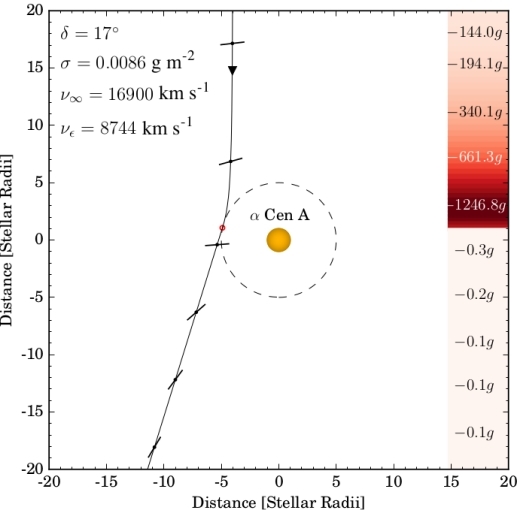
Image: Figure 1 from the paper. Caption: Trajectory of a lightsail performing a photogravitational assist at α Cen A (orange circle). The bar along the trajectory visualizes the instantaneous orientation of the sail determined to maximize the deceleration. The values in the legend denote the deflection angle, the mass-to-surface ratio, the inbound velocity, and the outbound velocity of the sail. The color bar at the right shows the g-forces acting on the sail along the trajectory, where g = 9.81 m s −2 is the acceleration on the Earth’s surface. Credit: Heller, Hippke and Kervella.
The revised work thus changes the original Proxima b mission. Assuming the intent is to brake into the Proxima system for close examination of the planet, then the sail is better oriented so as to avoid maximum deceleration during its encounter with Centauri B. This allows the cruise to Proxima to continue with a residual speed of 1,270 km s-1, which is the maximum speed that can be used to fully brake into the Proxima system. As you can see, the authors must juggle the fastest possible cruise times with the maximum injection speeds.
So we have learned that when the photogravitational assist is made at the same side of the star as the desired deflection, as opposed to a gravitational swing behind the star (the method of the original paper), the injection speed at Centauri A (and thus cruise speed enroute) is increased substantially. The authors’ calculations involving a graphene lightsail show an injection speed (v∞, max) of 17,050 km s-1 for the new method (this works out to 5.7% c, as opposed to the previous 13,800 km s-1, which is 4.6% of c). We get an increase in speed of 24 percent, while we reduce travel times from Earth to Centauri A and B from 95 years to 75 years.
Adding in the travel time to Proxima Centauri after the photogravitational assists at Centauri A and B, we get a total travel time from Earth to a bound orbit in the Proxima Centauri system of 121 years, with the final 1,280 km s-1 absorbed through photon braking at Proxima itself. 46 years, in other words, is needed to go from Centauri AB to Proxima. What a shame we can’t launch such a mission this year, for the alignment in the Centauri system is such that a mission arriving at Centauri AB in 2092 would allow minimum travel times and maximum injection speeds. In 2092 the deflection required by the sail for the AB photogravitational assist is smallest.

Image: Figure 2 from the paper. Orbital trajectories of α Cen A (orange) and B (red) in their barycentric coordinate system as seen from Earth using differential RA and Dec coordinates. The AB vector at the time of their closest apparent encounter in 2092.69 (8 September 2092) is marked in blue. Credit: Heller, Hippke and Kervella.
It should be clear from all this that to calculate the actual value of the maximum injection speed at Centauri A and B, we need to calculate the deflection angle required by the sail to make the necessary trajectory adjustments. This will be the case in any nearby system to which we hope to apply these methods. And here we find the interesting result that there are systems which could be closer in terms of travel time than Alpha Centauri itself. Tomorrow we’ll return to this paper to look at the possibilities for photogravitational assists to bound orbits in other systems.
The paper is Heller, Hippke and Kervella, “Optimized trajectories to the nearest stars using lightweight high-velocity photon sails” (preprint).






April 14, 2017
New Findings on Enceladus, Europa
Jim Green, who is director of the Planetary Science Division at NASA headquarters, clearly loves his job, and he got so excited during Thursday’s news conference that he kept interchanging Enceladus with Europa in his remarks. Both were in play during the discussion, and the context made it clear what he intended, but I always get a kick out of seeing that kind of enthusiasm showing forth in scientists and academics. It’s a reminder of why they got involved in the first place, and for that matter, what drew me into writing about the field myself.
The news delivered in the press conference and through two new papers involves two older space missions that are driving planning for yet a third, the Europa Clipper mission, a Jupiter orbiter that is still in the design and planning stages. And with Cassini in its final months of operation, it’s fitting that a Cassini flyby through the Enceladus plumes in 2015 should result in what Cassini project scientist Linda Spilker (JPL) called a ‘capstone finding.’ Hydrogen has turned up in the plumes, which turn out to be about 98 percent water vapor and 1 percent hydrogen, with a mix of carbon dioxide, methane and ammonia making up the rest.
Cassini’s Ion and Neutral Mass Spectrometer (INMS) instrument has, in other words, shown us, a potential pointer to what any Enceladus microbes might use to stay alive. For hydrogen must be entering the subsurface ocean because of hydrothermal activity on the seafloor.
We don’t know that life exists here, but provocatively enough, hydrogen can be a source of chemical energy, combining with carbon dioxide dissolved in the apparently abundant water beneath the surface of Enceladus. ‘Methanogenesis’ is the name of this reaction because methane is produced as a by-product. Add to this energy source the fact that we also have carbon, nitrogen and oxygen. If phosphorus and sulfur also exist in that ocean (and the prospects are good), then the case for Enceladus as a venue for life strengthens.
So we have powerful evidence that rock deep inside Enceladus is interacting with hot water. Think back 40 years to the arrival of the Viking landers on Mars and you’ll recall that at roughly the same time, oceanographers were finding unexpected life forms around hydrothermal vents on Earth. Hydrothermal fluids beneath the ocean floor were driving geochemical transformations in which minerals rich in iron react with water to form new minerals. Chris Glein (SwRI) said that the Cassini findings show that geochemistry is likewise active on Enceladus.

Image: The graphic shows water from the ocean circulating through the seafloor, where it is heated and interacts chemically with the rock. This warm water, laden with minerals and dissolved gases (including hydrogen and possibly methane) then pours into the ocean creating chimney-like vents. The hydrogen measurements were made using Cassini’s Ion and Neutral Mass Spectrometer, or INMS, instrument, which sniffs gases to determine their composition. The finding is an independent line of evidence that hydrothermal activity is taking place in the Enceladus ocean. Previous results from Cassini’s Cosmic Dust Analyzer instrument, published in March 2015, suggested hot water is interacting with rock beneath the ocean; the new findings support that conclusion and indicate that the rock is reduced in its geochemistry. With the discovery of hydrogen gas, scientists can now conclude that there is a source of chemical free energy in Enceladus’ ocean. Credit: NASA/JPL-Caltech/Southwest Research Institute.
It’s an exciting thought, though we don’t know if any parallels to life around Earth’s ‘white smokers’ far below the surface exist. We do know that forms of life can feed on chemical energy rather than sunlight, with that process of methanogenesis combining H with CO2 to produce methane and extract energy out of the process. As Glein pointed out, we’re now looking at the first calorie count in an alien ocean, with life as a geochemical possibility.
An older mission, the Galileo Jupiter orbiter that gave us our best imagery of Europa, accounted for the second discovery announced yesterday. This one was not a complete surprise, as we had already found evidence of a possible plume on Europa through observations from the Hubble Space Telescope. But the 2014 detection of a plume is now bolstered by a 2016 detection. The Galileo data are crucial here because thermal imagery of the area in question, taken by the spacecraft in the 1990s, shows a hot spot, a ‘thermal anomaly,’ as William Sparks (Space Telescope Science Institute) called it. The region also contains surface features that appear to be cracks in the moon’s ice crust.
“The plumes on Enceladus are associated with hotter regions, so after Hubble imaged this new plume-like feature on Europa, we looked at that location on the Galileo thermal map. We discovered that Europa’s plume candidate is sitting right on the thermal anomaly,” said Sparks.
It was Sparks who led the Hubble plume studies in both 2014 and 2016.
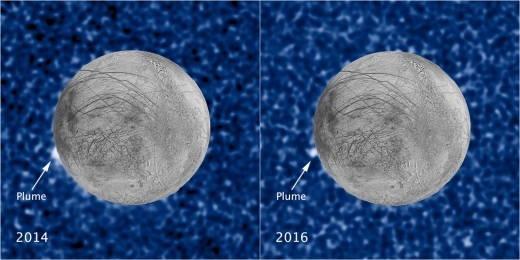
Image: These composite images show a suspected plume of material erupting two years apart from the same location on Jupiter’s icy moon Europa. The newly imaged plume, shown at right, rises about 100 kilometers above Europa’s frozen surface. The image was taken Feb. 22, 2016. The plume in the image at left, observed by Hubble on March 17, 2014, originates from the same location. It is estimated to be about 50 kilometers high. The snapshot of Europa, superimposed on the Hubble image, was assembled from data from NASA’s Galileo mission to Jupiter. Credit: NASA/ESA/W. Sparks (STScI)/USGS Astrogeology Science Center.
Finding a hot spot in the same place as the candidate position for the detected plumes gives us further evidence that the Europan ocean can communicate with the surface, although its activity is not as spectacular as the numerous venting jets we see at Enceladus’ south pole. The new plume rises about 100 kilometers above the Europan surface, about twice as high as the one observed in 2014, and both correspond to the thermal region imaged by Galileo.
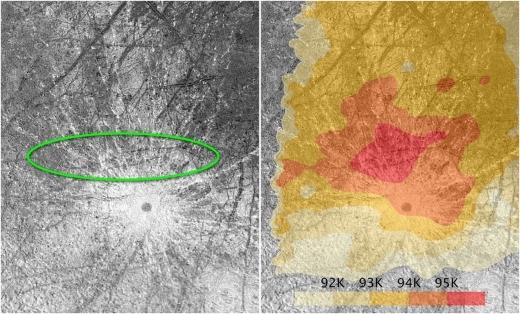
Image: These images of the surface of the Jovian moon Europa, taken by NASA’s Galileo spacecraft, focus on a “region of interest” on the icy moon. The image at left traces the location of the erupting plumes of material, observed by NASA’s Hubble Space Telescope in 2014 and again in 2016. The plumes are located inside the area surrounded by the green oval. The green oval also corresponds to a warm region on Europa’s surface, as identified by the temperature map at right. The map is based on observations by the Galileo spacecraft. The warmest area is colored bright red. Credit: NASA/ESA/W. Sparks (STScI)/USGS Astrogeology Science Center.
Assuming a linkage between the plumes and the warm spot on the surface, researchers believe that liquid water being vented from below the crust could be warming the area around the plume. Another possibility is that water vapor being ejected from the plume falls back to the surface in a mist that changes the structure of local surface grains and lets them retain heat longer than the surrounding regions. We should learn a great deal more with Europa Clipper.
Planned for a launch in the next decade, Europa Clipper can draw on both sets of findings discussed yesterday. We can envision a probe that, like Cassini, can fly through the plumes of a distant moon, hoping to extract information about the ocean beneath. The spacecraft, which will make numerous close flybys of the moon, will carry nine major instruments. Its magnetometer should help us measure the size of the ocean, while ice penetrating radar can help us measure the thickness of the ice. We’ll also use thermal imaging, like Galileo, to look for other hot spots, and learn if there are cracks associated with these regions. Also in the works: A next generation version of Cassini’s Ion and Neutral Mass Spectrometer (INMS) instrument, and an ultraviolet camera to enhance the hunt for plumes.
Thus we learn, by a series of steps each leading to the next, mission building on mission to suggest the scope and shape of the mission to follow. We’re about to lose Cassini, but we lost Galileo in 2003 when it plunged into the atmosphere of Jupiter. Even so, its data continue to inform us how to interpret these new findings. Meanwhile, Hubble observations of Europa using its Space Telescope Imaging Spectrograph (STIS) continue to look for new plume activity. When Europa Clipper flies, it will be designed to answer questions earlier studies have raised.
The paper on Enceladus is Waite et al., “Cassini finds molecular hydrogen in the Enceladus plume: Evidence for hydrothermal processes,” Science Vol. 356, Issue 6334 (14 April 2017), 155-159 (abstract). The paper on Europa is Sparks et al., “Active Cryovolcanism on Europa?” Astrophysical Journal Letters Vol. 839, No. 2 (13 April 2017). Abstract available.






April 13, 2017
Investigation of a Possible Dwarf Planet
Astronomical investigations can overlap in extremely helpful ways. Consider the Dark Energy Survey, which examines some 12 percent of the sky in an attempt to learn more about whatever force is accelerating the expansion of the universe. DES is trying to map hundreds of millions of galaxies and identify thousands of supernovae while looking for patterns in cosmic structure, using a 570-Megapixel digital camera, DECam, mounted on the Blanco 4-meter telescope at Cerro Tololo Inter-American Observatory (Chile).
What DES produces are thousands of images — its initial search uncovered 1.1 billion candidate objects, most of which are galaxies or background stars. But among the objects are some that move in successive observations, the signature of objects in our Solar System. David Gerdes (University of Michigan) was able to find what appears to be a dwarf planet within the dataset. Called 2014 UZ224 and informally known as DeeDee (for Distant Dwarf), the object has now been characterized in a new paper from Gerdes and team.
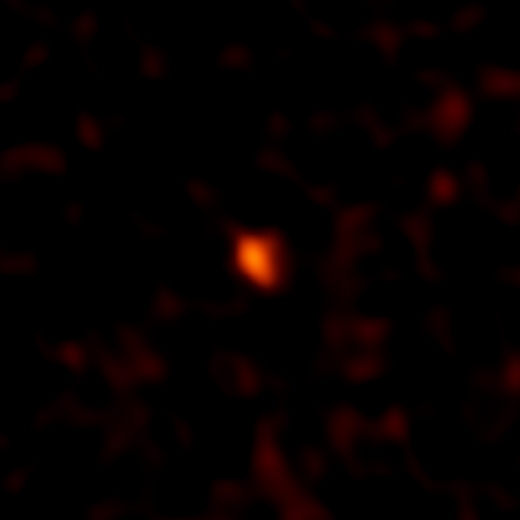
Image: ALMA image of the faint millimeter-wavelength “glow” from the planetary body 2014 UZ224, more informally known as DeeDee. Credit: ALMA (ESO/NAOJ/NRAO).
The data behind the paper come from observations using the Atacama Large Millimeter/submillimeter Array (ALMA), a radio telescope installation at about 5000 meters altitude in the Atacama desert of northern Chile. 2014 UZ224 turns out to be about 635 kilometers across, which makes it two-thirds the diameter of Ceres. This should make the object massive enough to be spherical, allowing it to be considered a dwarf planet. It is, in any case, an object in an area thought to be rich in trans-Neptunian objects:
“Far beyond Pluto is a region surprisingly rich with planetary bodies. Some are quite small but others have sizes to rival Pluto, and could possibly be much larger,” says Gerdes. “Because these objects are so distant and dim, it’s incredibly difficult to even detect them, let alone study them in any detail. ALMA, however, has unique capabilities that enabled us to learn exciting details about these distant worlds.”
The object orbits among a population that we are still learning how to categorize. Some trans-Neptunian objects are members of the scattered disk and inner Oort cloud population, reaching well beyond the Kuiper Belt to distances of hundreds of AU. DeeDee is now some 92 AU out in an orbit that would take more than 1100 years to complete (aphelion is at about 180 AU). Sedna, considered to be an extended scattered disc object (E-SDO), is now 86 AU from the Sun (aphelion 936 AU), while Eris is currently at 96.3 AU (aphelion 97.6 AU). The Minor Planet Center currently lists over 2000 objects in the overall category of TNOs.
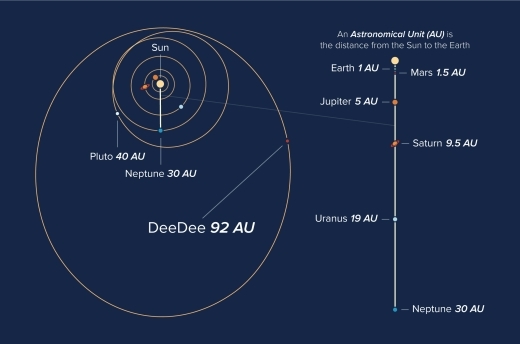
Image: Orbits of objects in our Solar System, showing the current location of the planetary body 2014 UZ224. Credit: Alexandra Angelich (NRAO/AUI/NSF).
We can expect numerous TNO discoveries ahead, as the paper explains:
The population of detected TNOs is of course strongly biased toward those that are large, near perihelion, and/or have high albedo. Current surveys such as the DES now have the depth and area coverage to discover the counterparts of known objects that are well beyond perihelion. It is also noteworthy that the ALMA facility is easily capable of radiometric detection of a 600 km body at > 90 AU distance. Hence it will be possible to establish sizes and albedos for nearly every body detectable in the visible by DES and similar surveys. As these surveys progress, we will be able for example to determine whether the very high albedo of Eris is characteristic of large bodies at this distance, or whether flux selection has led to the first discovery being atypical.
Working at millimeter wavelengths, Gerdes and his fellow researchers were able to calculate that the surface of DeeDee is at a temperature of 30 Kelvin, not far above absolute zero. The object’s size could be calculated by comparing the ALMA observations to the optical information from DECam and the Blanco instrument at Cerro Tololo. The possible dwarf planet reflects about 13 percent of the sunlight that strikes it based upon its heat signature (according to this NRAO news release, that’s about the same reflectivity as a baseball infield).
The paper is Gerdes et al., “Discovery and Physical Characterization of a Large Scattered Disk Object at 92 AU,” Astrophysical Journal Letters Vol. 839, No. 1 (12 April 2017). Abstract / preprint.






April 12, 2017
NIAC 2017: Interstellar Implications
I always look at the NASA Innovative Advanced Concepts (NIAC) awards with interest as well as a bit of nostalgia. When I began researching the book that would become Centauri Dreams, NIAC was an early incentive. Then known as the NASA Institute for Advanced Concepts, it was under the direction of Robert Cassanova (this was back around 2002), and its archive of funded studies was a treasure house of deep space ideas, from antimatter extraction in planetary magnetic fields to exoplanet imaging through starshades. I spent days going through any number of reports and interviewed many NIAC study authors.
You can still see the NIAC reports from that era on the older site (go to NIAC Funded Studies). The current NIAC site makes the point that the program looks for “non-traditional sources of innovation that study technically credible, advanced concepts that could one day ‘change the possible’ in aerospace.” And it’s here that we get the 2017 Phase 1 proposals, a $125,000 award for a nine month period that can result in a two-year Phase II follow-up.
Laser-Fed Ion Drive for Interstellar Precursor
2017 proposals with specifically interstellar intent include one from JPL’s John Brophy, who describes what he calls “A Breakthrough Propulsion Architecture for Interstellar Precursor Missions.” Brophy is looking for a way to deliver a high spacecraft velocity change (delta-V) without using much propellant. He envisions a lithium-fueled ion thruster with a specific impulse of 58,000 seconds (compare this with the Dawn spacecraft’s 3,000 seconds).
How to achieve this? By use of a 10-km orbital laser array that allows his craft to operate far beyond the point where sunlight loses its useful effect, the array feeding a lightweight, photovoltaic array aboard the spacecraft that can produce the electric power to drive the thrusters. Brophy believes laser power in this configuration can be converted to electric power at an efficiency of 70 percent, to produce an output voltage of 12 kV. The lithium fueled system would be capable of a 12-year flight-time to 500 AU, close to the point where gravitational lensing begins to get interesting. Time to Pluto: 3.6 years, and Jupiter in a single year.
So much depends upon that laser array, a ground-based version of which is under active study by the Breakthrough Starshot effort. The problems of implementing such an array are daunting, but its uses if ever built are so game-changing that the investigation continues. Breakthrough Starshot itself works with a 30-year horizon, so we are not talking about near-term implementation, but rather sketching out concepts a laser array could make feasible.
[image error]
Image: Breakthrough Propulsion Architecture for Interstellar Precursor Missions
Credit: John Brophy.
Counting on Ernst Mach
Like Brophy’s proposal, Heidi Fearn’s “Mach Effects for In Space Propulsion: Interstellar Mission” is a Phase 1 initiative, an interesting entry because it shows NIAC beginning to open to the kind of breakthrough propulsion concepts NASA once investigated through its Breakthrough Propulsion Physics project (led by Tau Zero founder Marc Millis). In this case, the work goes toward a so-called Mach Effect Thruster (MET). Mach effects are transient variations in the rest masses of objects as predicted by standard physics where Mach’s principle applies. Proponents believe they offer the possibility of producing thrust without the ejection of propellant, as discussed in James Woodward’s Making Starships and Stargates: The Science of Interstellar Transport and Absurdly Benign Wormholes (Springer-Verlag, 2012).
What Fearn proposes is to investigate such thrusters by continuing the development of laboratory-scale devices while designing and developing power supply and electrical systems that will determine the efficiency of the Mach Effect Thruster. The analytical task is to improve theoretical thrust predictions and build a reliable model of the device. At the theoretical level, this team is definitely talking deep space, with part of the proposal being to:
Predict maximum thrust achievable by one device and how large an array of thrusters would be required to send a probe, of size 1.5m diameter by 3m, of total mass 1245 Kg including a modest 400 Kg of payload, a distance of 8 light years (ly) away.
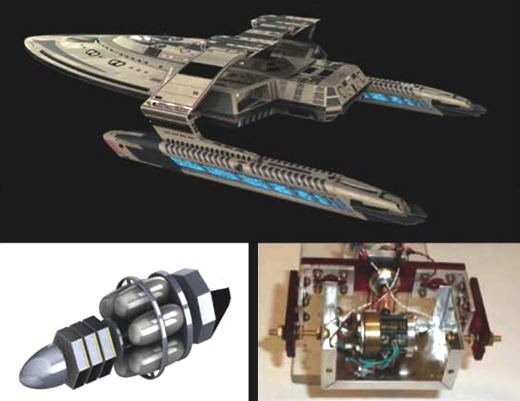
Image: Mach Effects for In Space Propulsion: Interstellar Mission. Credit: Heidi Fearn.
Can such a device work? Remember, we are in the realm of advanced concepts, where the technology is at the TRL 1 level, but the benefits of working with a thruster that does not expel fuel mass could make high velocities possible, enough of an incentive to pursue these early steps. Mach’s principle relates the motion of the farthest objects in the universe to the local inertial frame or, as Hawking has it, “Local physical laws are determined by the large-scale structure of the universe.” The principle is vague enough that Hermann Bondi and Joseph Samuel have compiled eleven different variations on it, all of which could be called Machian.
Gravitational Lensing and Exoplanet Imaging
JPL’s Slava Turyshev is behind a Phase 1 study called “Direct Multipixel Imaging and Spectroscopy of an exoplanet with a Solar Gravity Lens Mission,” a study focusing on a mission to exploit the Sun’s gravitational lens, where (at 550 AU and beyond) the Sun’s gravity has bent the light of objects directly behind it to allow powerful lensing effects.
Long-time Centauri Dreams readers will know that the Italian physicist Claudio Maccone has championed a gravitational lens mission called FOCAL for many years, proposing it to the European Space Agency and writing numerous papers as well as two books on the topic (there is much available in the archives here about this concept). The definitive book, Deep Space Flight and Communications: Exploiting the Sun as a Gravitational Lens (Springer, 2009) lays out the principles of such lensing, the history of its study, and potential solutions to the many imaging issues raised by a space mission. Maccone has discussed lensing as one solution to the communications challenges of Breakthrough Starshot.
What Turyshev is proposing is to study not the means of getting to 550 AU and beyond, but the question of spacecraft operations at such distances. From the proposal description:
Specifically, we propose to study I) how a space mission to the focal region of the SGL (Solar Gravitational Lens) may be used to obtain high-resolution direct imaging and spectroscopy of an exoplanet by detecting, tracking, and studying the Einstein’s ring around the Sun, and II) how such information could be used to unambiguously detect and study life on another planet.
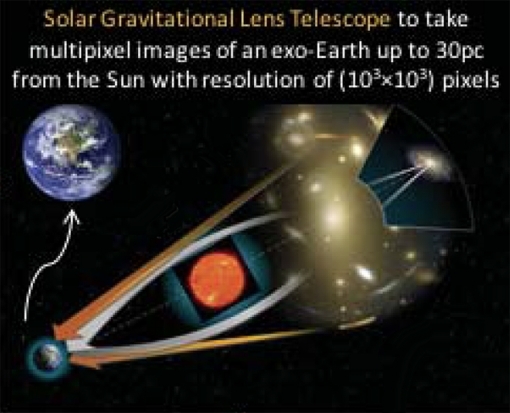
Image: Direct Multipixel Imaging and Spectroscopy of an exoplanet with a Solar Gravity Lens Mission. Credit: Slava Turyshev.
Other proposals of interest are “Pluto Hop, Skip and Jump Global,” from Benjamin Goldman (Global Aerospace Corporation), an innovative study of a Pluto lander with a novel approach to landing and in situ science; “Gradient Field Imploding Liner Fusion Propulsion System” from Michael LaPointe (NASA MSFC), exploring magneto-inertial fusion in a new configuration that could lend itself to in-space propulsion; and “Fusion-Enabled Pluto Orbiter and Lander,” from Stephanie Thomas (Princeton Satellite Systems, Inc.), a Direct Fusion Drive concept based on work under development at the Princeton Plasma Physics Laboratory, and its application in a Pluto orbiter with lander (this one is a Phase II study).
The full list of 2017 Phase I and Phase II selections is here, including Nan Yu’s interesting take at JPL on possible dark energy interactions with a ‘Solar System laboratory.’ Have a look at these and ask yourself which we may still be talking about a decade hence. When I look back to the NIAC studies I examined in 2002 and later, I find many ideas that we wound up discussing at length here on the site, and I wouldn’t be surprised if several of the new selections move on to Phase II status and a great deal of future scrutiny. Which ones will they be?






April 11, 2017
Outer System News
NASA is to discuss new findings about ocean worlds in our Solar System in a news conference at 1400 EDT (1800 UTC) on Thursday. The prospects for oceans in the outer system are surprisingly varied, ranging from the strong evidence of a subsurface, salty ocean on Europa to other Jovian moons like Ganymede and Callisto, and of course, Saturn’s intriguing moon Enceladus. Titan is thought to have a salty ocean perhaps 50 kilometers below its ice shell, while there are also possible ocean venues on Mimas, Triton and even Pluto.
The news briefing participants will be:
Thomas Zurbuchen, associate administrator, Science Mission Directorate at NASA Headquarters in Washington
Jim Green, director, Planetary Science Division at NASA Headquarters
Mary Voytek, astrobiology senior scientist at NASA Headquarters
Linda Spilker, Cassini project scientist at NASA’s Jet Propulsion Laboratory in Pasadena, California
Hunter Waite, Cassini Ion and Neutral Mass Spectrometer (INMS) team lead at the Southwest Research Institute (SwRI) in San Antonio
Chris Glein, Cassini INMS team associate at SwRI
William Sparks, astronomer with the Space Telescope Science Institute in Baltimore
Further information and a link to view the news briefing can be found here, and the event will also be streamed live on YouTube.
Elsewhere in the Outer System
New Horizons is now in hibernation, a mode that will last until early September. While the spacecraft slumbers, the science and mission operations teams will be working on command loads for the flyby of Kuiper Belt Object MU69, planning for a nine-day encounter with closest approach on New Year’s Day of 2019. We’re now 38.15 AU from the Sun and 5.07 AU from Pluto, moving with a heliocentric velocity of 14.29 kilometers per second.
[image error]
At Ceres, the Dawn spacecraft is in its extended mission and now studying the dwarf planet in a highly elliptical orbit. Later this month, the Sun will be directly behind the spacecraft, when it is at an altitude of about 20,000 kilometers. The strong lighting may help tease out new features about the surface, even as the primary science objective — to measure cosmic rays as part of the analysis of chemical elements near the surface — continues.
We’re also learning more about what appears to be a transient atmosphere around the dwarf planet. A new study points to the Sun as the source of the atmosphere’s intermittent nature. The paper, published in Astrophysical Journal Letters, makes the case that energetic particles from the Sun’s solar wind can free water molecules from the ground, producing an atmosphere, vanishingly thin, that may last for up to a week.
“Our results also have implications for other airless, water-rich bodies of the solar system, including the polar regions of the moon and some asteroids,” says Chris Russell (UCLA), principal investigator of the Dawn mission. “Atmospheric releases might be expected from their surfaces, too, when solar activity erupts.”
If this sounds like cometary behavior, with ice sublimating at the surface as the comet nears perihelion, the paper plays down the idea, noting that the activity does not seem timed to Ceres’ closest approach to the Sun. Lead author Michaela Villarreal (also at UCLA), adds that the team does not believe sublimation can explain the observed exosphere. Earlier detections of an atmosphere on Ceres coincided with higher concentrations of energetic particles from the Sun, and non-detections occurred at lower particle levels.
Thus solar activity rather than Ceres’ orbital position seems to be the cause. This leads to a prediction: Given that the Sun is now in a relatively quiet period that is expected to last for several years, the authors predict that we will see little atmosphere on Ceres during this time. This should be the case even though Ceres is currently getting closer to the Sun.
The evidence for ice on Ceres is strong, with the spacecraft’s gamma ray and neutron detector (GRaND) finding an uppermost surface rich in hydrogen and consistent with water ice; the ice is nearer to the surface at higher latitudes. Dawn has directly detected ice at Oxo crater and in one of the craters that are persistently in shadow in the northern hemisphere. And according to this JPL news release, we know that the shapes of craters and other surface features are consistent with water ice in Ceres’ crust.
https://photojournal.jpl.nasa.gov/archive/PIA21081_figA.mp4
Image: The dwarf planet Ceres overlaid with the concentration of hydrogen determined from data acquired by the gamma ray and neutron detector (GRaND) instrument aboard NASA’s Dawn spacecraft. The hydrogen is in the upper meter of regolith, the loose surface material on Ceres. The color scale gives hydrogen content in water-equivalent units, which assumes all of the hydrogen is in the form of H2O. Blue indicates where hydrogen content is higher, near the poles, while red indicates lower content at lower latitudes. In reality, some of the hydrogen is in the form of water ice, while a portion of the hydrogen is in the form of hydrated minerals (such as OH, in serpentine group minerals). The color information is superimposed on a shaded relief map for context. Credit: NASA/JPL-Caltech/UCLA/MPS/DLR/IDA/PSI.
The evidence for a faint atmosphere on Ceres preceded Dawn’s arrival in 2015. As far back as 1991, the International Ultraviolet Explorer satellite found hydroxyl emission from Ceres, although no such emissions could be detected the year before. The European Space Agency’s Herschel Space Observatory likewise detected water in the possible atmosphere on three separate occasions, but was unable to find an atmopshere on the fourth attempt. The solar activity theory gives us a way to explain the transient nature of this thin atmosphere.
The paper is Villarreal et al., “The Dependence of the Cerean Exosphere on Solar Energetic Particle Events,” Astrophysical Journal Letters Vol. 838, No. 1 (24 March 2017). Abstract available.






April 10, 2017
The Value of an Exo-Venus
Looking back at science fiction’s treatment of Venus, you can see a complete reversal by the 1960s, at which time we had learned enough about the planet to render earlier depictions invalid, and even quaint. Think back to the inundated surface of Venus in Bradbury’s “Death by Rain” (1950) or Henry Kuttner and C. L. Moore’s Clash by Night (1943), where humans live under water and the land surfaces are carpeted with jungle. Heinlein’s Space Cadet is another example of a fecund Venus much like an Earthly rain forest.
But by 1965, Larry Niven would be writing “Becalmed in Hell,” about a nightmare Venus based on our insights into its intolerable surface. I should also mention a prescient tale by a writer who is a personal favorite of mine, James Gunn. It’s “The Naked Sky” (1955), which shows us a desert Venus with hydrochloric acid clouds and huge atmospheric pressure, a land Gunn described as “embalmed at birth.” As far as I know, this was the first SF tale that began to get Venus accurately, though at the time Gunn wrote, spacecraft had yet to confirm the hypothesis.
By 1962, we would have Mariner 2 readings of surface temperatures on Venus, while Soviet Venera probes would begin their work in 1967 with the first landing of a man-made object (Venera 4) on another planet. The program would continue for 16 launches, with 10 successful landings on the planet. Venera found a surface hot enough to melt lead, and survival times were short, with even the final iterations lasting no longer than about two hours.
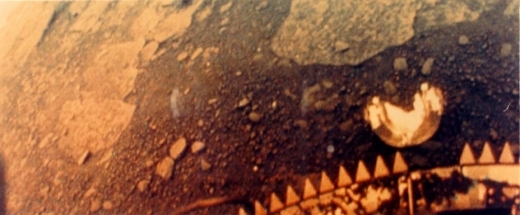
Image: An image from the Soviet Venera 13 spacecraft. This was the first of the Venera missions to include a color TV camera and the first to succeed in obtaining pictures since Venera 10. Venera 13 lander touched down on 3 March 1982.
Now we’re finding planets much like Venus — or with the potential of being so — around other stars. With all the current interest in identifying an Earth 2.0, why be interested in Venus analogues? Elisa Quintana (NASA GSFC/SETI Institute), who works with the Kepler team, is one of the discoverers of such a world, Kepler 1649b. And here’s her take:
“Many people are hung up on finding other Earths. But Venus analogs are just as important. Since new telescopes coming down the pike will allow us to probe atmospheres, focusing on both Earth and Venus analogs may help decipher why, in our Solar System, one planet allows life to thrive, and one does not, despite having similar masses, comparable densities, etc.”
It’s a telling point, because the reason we got all those science fiction tales about a jungle Venus is that in so many ways it seemed to be a twin of the Earth, albeit one that was 40 percent closer to the Sun. It was easy to transfer tropical traits to the place, as if a journey there were somewhat like heading into unexplored equatorial terrain on our own planet.
Although Kepler 1649b circles a red dwarf star about 220 light years away, it receives about 2.3 times the stellar flux that the Earth does. The number for Venus is 1.9 times the terrestrial value. Looking into what makes Venus the nightmare it is can help us understand habitable zone boundaries around M-dwarfs that much better as we examine the tidal effects and stellar activity through flares and stellar wind that distinguish red dwarf planets from the Sun’s.
Follow-up spectroscopy and imaging of Kepler 1649 indicated to lead author Isabel Angelo (SETI Institute) and team that the parameters of the star had to be adjusted. It turned out to be considerably hotter and larger than had been thought, the adjusted figures affecting the planet observed in transit. We now know that Kepler 1649b is just slightly larger than Earth. This is another case where Kepler planets have been re-characterized because of revisions to the properties of the host star, and a reminder of the importance of such follow-ups.
We learn from all this that the planet is on a 9-day orbit, but it is too small to produce solid radial velocity data that would help determine its mass, leading the authors to make no conclusions about mass or composition. The likelihood, though, considering that Kepler 1649b is 1.08 times the radius of the Earth, is that we are dealing with a rocky world. The paper compares the planet to Kepler-186f, an Earth-sized exoplanet thought to orbit in the habitable zone of another M-dwarf. Flares and coronal mass ejections are factors around such stars, while tidal locking and heating could affect the geological activity on both. The authors consider the two to be good candidates for Earth- and Venus-analog studies.
From the paper:
The discovery of Kepler-1649b is part of a larger movement toward confirmation and characterization of a variety of Earth-sized exoplanets, with the ultimate goal of understanding what factors place constraints on habitability. Most of these planets have orbital periods measured to high precision, allowing us to calculate the flux received by the planet from its host star. As a result, determining the correlation between incident flux and atmospheric compositions would be highly useful in assessing the habitability of known exoplanets. More specifically, determining the compositions and atmospheres of planets like Kepler-1649b and Kepler-186f, two planets that together span a wide range of distances within the habitable zones of M-dwarfs, will be useful in understanding the nature of habitable zone boundaries for such star types. Future missions like K2, TESS, and JWST… will make these studies possible and therefore lend themselves to a better understanding of conditions required for exoplanet habitability.
Confirming what surface conditions are actually like on either world will demand spectroscopic analysis of their atmospheres, and when it comes to Venus analogues, this is a tricky proposition because of their opacity. But the paper adds that there are distinguishing features in the high clouds of Venus like carbon dioxide absorption and an upper haze layer with sulfuric acid, that could make detection possible. The thick atmosphere dominated by clouds also produces scattering and reflection effects that lead to high albedo, which the authors see as another piece of evidence that could link an atmosphere to a runaway greenhouse.
All such studies rely upon our confidence in the properties of the planets we find, and that means accurate information about their host stars. Missions like Gaia are designed to measure the distances to nearby exoplanet systems like Kepler-1649 through the most precise parallax measurements ever obtained, which should further tighten the parameters on systems like this one. We need to know more about the factors that can take two worlds of similar mass and density in our system and render one habitable while turning the other into a furnace.
The paper is Angelo et al., “Kepler-1649b: An Exo-Venus in the Solar Neighborhood,” Astronomical Journal Vol. 153, No. 4, published online 17 March 2017 (abstract and full text).






April 7, 2017
Atmosphere Detected around Super-Earth GJ 1132b
There’s interesting news this morning about planets around M-dwarfs. A team of astronomers led by John Southworth (Keele University, UK) has detected an atmosphere around the transiting super-Earth GJ 1132b. While we’ve examined the atmospheres of gas giants and have detected atmospheres on the super-Earths 55 Cancri e and GJ 3470 b, GJ 1132b is the smallest world yet where we’ve detected one. 39 light years from Earth in the constellation Vela, the transiting planet is 1.4 Earth radii in size, with a mass 1.6 times that of our world.
We’re continuing to move, in other words, into the realm of lower-mass planets when we study planetary atmospheres, an investigation that will be crucial as we look for biosignatures in distant solar systems. With GJ 1132b, we’re dealing with a planet too close to its star to be habitable (it receives 19 times more stellar radiation than the Earth does, and has an equilibrium temperature of 650 K, or 377° C). But finding a thick atmosphere here is encouraging given the level of flare and stellar wind activity on M-dwarfs.
Such activity could strip a planet of its atmosphere in some scenarios, so the survival of atmospheres on planets in the habitable zone of similar stars remains in play. In GJ 1132b, we have a planet whose atmosphere has evidently persisted for billions of years.
The GJ 1132b work was done with the GROND imager attached to the 2.2 m ESO/MPG telescope at La Silla. GROND (Gamma-ray Burst Optical/Near-infrared Detector) is normally used to study Gamma Ray Burst afterglows at seven different wavelengths from the optical to near-infrared, allowing rapid follow-up spectroscopic observations at other telescopes, but it can also be used to study exoplanets as well as optical, X-ray and radio transients.
Using GROND, the researchers could measure the decrease in brightness as the planet’s atmosphere absorbed some of the starlight while passing in front of the star in transit. The team’s intention was to determine the radius of the planet in each of the seven passbands (filters) for which it could obtain transit lightcurves, analyzing the significance of variations between the passbands in terms of atmospheric composition.
The result: The planet appeared larger at some wavelengths than others, an indication of an atmosphere opaque to specific wavelengths while transparent otherwise. The average radius of the planet could be separated out into a surface radius of 1.375 Earth radius overlaid by this atmosphere, which increases the observed radius at the wavelengths mentioned.
Simulating different atmospheres through follow-up work from team members at the University of Cambridge and the Max Planck Institute for Astronomy, Southworth and company found that an atmosphere rich in water and methane fit their observations. As to what the planet’s surface composition might be, two possibilities emerge. From the paper:
We find that the mass and radius are consistent with two broad compositional regimes. Firstly, an exactly Earth-like composition, with 33% iron, 67% silicates and no volatile layer, is inconsistent with the data within the 1σ uncertainties. But, a composition with higher silicate-to-iron fraction, including a pure silicate planet, is ostensibly consistent with the data, albeit marginally.
So perhaps a rocky world, or perhaps not:
On the other hand, the data are also consistent with a large range of H2O mass fractions between 0% and 100% in our models. In principle, consideration of temperature-dependent internal structure models would lead to larger model radii for the same composition… and therefore could lower the upper limit on the water mass fraction. Nevertheless, the mass and radius of GJ 1132 b allow for a degenerate set of solutions ranging between a purely silicate bare-rock planet and an ocean planet with a substantial H2O envelope.
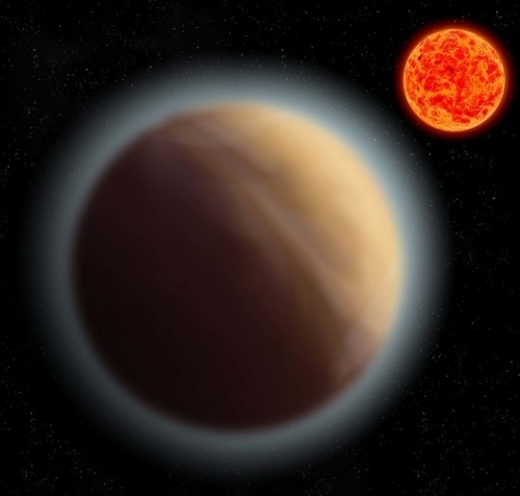
Image: Artist’s impression of the exoplanet GJ 1132 b, which orbits the red dwarf star GJ 1132. Credit: MPIA.
The authors advocate extensive follow-up work on this planet with instruments like the Hubble Space Telescope, ESO’s Very Large Telescope, and the James Webb Space Telescope. In particular, we can begin to delve into the atmosphere here to look for its constituents:
Intermediate-band photometry at 900 nm or bluer than 500 nm would enable finer distinctions to be made between competing model spectra and a clearer understanding of the chemical composition of the planetary atmosphere. The planet’s mean density measurement is also hindered by the weak detection of the velocity motion of the host star, an issue which could be ameliorated with further radial velocity measurements using large telescopes. Finally, infrared transit photometry and spectroscopy should allow the detection of a range of molecules via the absorption features they imprint on the spectrum of the planet’s atmosphere as backlit by its host star.
We’re getting close to the day when improved space- and ground-based installations will allow us to use transmission spectroscopy to look for biosignatures in the atmospheres of planets in the habitable zone of nearby red dwarfs, markers like oxygen, ozone, methane and carbon dioxide in a simultaneous presence that would indicate replenishment by living systems. We’re not there yet, but what we have here is a demonstration that a planet with 1.6 Earth’s mass in a tight orbit of its red dwarf host is capable of holding on to an extensive atmosphere.
The paper is Southwork et al., “Detection of the atmosphere of the 1.6 Earth mass exoplanet GJ 1132B,” Astronomical Journal Vol. 153, No. 4 (31 March 2017). Abstract / preprint.






April 6, 2017
New Horizons: Star Fields Beyond
The attitude you bring to a star field changes everything. When I was a kid trying to figure out how to use a small telescope, I scanned the usual suspects — the Moon, Saturn and its rings, the Galilean satellites of Jupiter — all the while planning to branch out into major wonders like M31 or the Ring Nebula in Lyra. But when I turned to deep sky objects, what I discovered was that I could see little more than faint smudges — I was using no more than a 3-inch reflector. It was a disappointment for a while, until I accepted the limitations of my equipment.
And then I became a cataloger of faint smudges, as avidly tracking down celestial objects as any stamp collector sorting through new finds. A patient uncle showed me how to look slightly away from the object I sought, to pick it up in peripheral vision. I began keeping notebooks listing my first glimpses of various nebulae and clusters. So many celestial objects were out of reach, but somehow a field of stars became wondrous not only for what I was seeing but for what I knew I might see with a larger instrument.
The image below recalled those days precisely because of what we cannot see in it. This is actually drawn from a series of images taken by New Horizons’ LORRI instrument showing the area toward which the craft is heading. We’re looking toward a close approach and flyby of the Kuiper Belt object MU69 at 0200 Eastern US time (0700 UTC) on New Year’s Day of 2019. Right now we’re still far enough way that the target isn’t visible even to LORRI, but to me this image is freighted with the raw excitement of exploration as we push ever deeper into the Solar System.
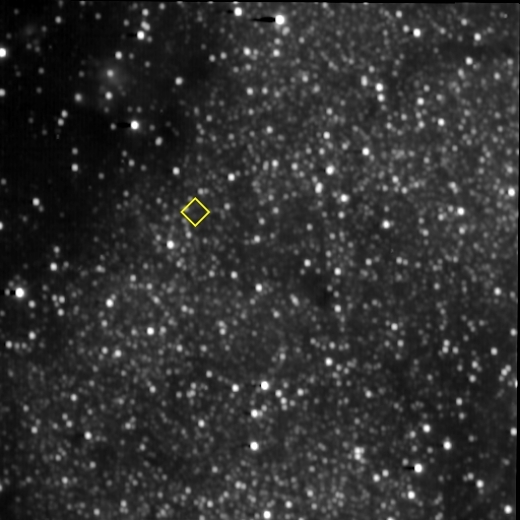
Image: In preparation for the New Horizons flyby of 2014 MU69 on Jan. 1, 2019, the spacecraft’s Long Range Reconnaissance Imager (LORRI) took a series of 10-second exposures of the background star field near the location of its target Kuiper Belt object (KBO). This composite image is made from 45 of these 10-second exposures taken on Jan. 28, 2017. The yellow diamond marks the predicted location of MU69 on approach, but the KBO itself was too far from the spacecraft (877 million kilometers) even for LORRI’s telescopic “eye” to detect. New Horizons expects to start seeing MU69 with LORRI in September of 2018 – and the team will use these newly acquired images of the background field to help prepare for that search on approach. Credit: NASA/Johns Hopkins University Applied Physics Laboratory/Southwest Research Institute
New Horizons is going into hibernation this week for a 157 day period, and I hadn’t realized until getting this JHU/APL update that the craft had been in full operational mode for almost two and a half years now, which of course dates back to the Pluto encounter and the long period of data return (16 months). Along the way New Horizons has continued to study the dust and charged particle environment of the Kuiper Belt as well as hydrogen in the heliosphere.
We’re now halfway between Pluto and MU69, having reached this point — a distance of 782.45 million kilometers from Pluto and MU69 — early on April 3 (UTC). The gravitational pull of the Sun continues to slow the craft, so it won’t be until tomorrow (April 7) that we reach the halfway point in terms of time between the two close approaches. Remember that New Horizons left Earth orbit traveling faster than any vehicle ever launched, but nine years of climbing out of the gravity well have slowed it to 14 kilometers per second at the Pluto/Charon flyby, significantly below the 17 kilometers per second-plus that Voyager 1 has attained.
The good news is that the mission includes further exploration beyond MU69. Hal Weaver is a New Horizons project scientist from the Applied Physics Laboratory (Laurel, MD):
“The January 2019 MU69 flyby is the next big event for us, but New Horizons is truly a mission to more broadly explore the Kuiper Belt. In addition to MU69, we plan to study more than two-dozen other KBOs in the distance and measure the charged particle and dust environment all the way across the Kuiper Belt.”
Looking ahead once we’re past MU69, there will be so many things we cannot see in the star field ahead. So much to discover for the deep space missions beyond New Horizons. When will a true interstellar probe — a mission designed from the start to examine the local interstellar medium — be launched? Without an answer, we can only keep pushing for exploration, an innate characteristic of our species, and one unlikely to be limited by our Solar System.






April 5, 2017
‘Blue Binaries’ Argue for Smooth Neptune Migration
We’re getting a few clues about the nature of planet migration in the early Solar System thanks to a class of objects being described as ‘blue binaries.’ Cold Classical Kuiper Belt Objects (CCKBOs) are generally reddish, but a population of widely separated binaries has now been identified that is thought to have originated in the inner edges of the Kuiper Belt.
The paper reporting on this work argues that these objects were pushed out a distance of over 4 AU to their present location among the CCKBOs as the result of gravitational interactions with Neptune billions of years ago, a movement induced by the migration of the planet from 20 to 30 AU. If so, we can draw some conclusions about that migration, and we’re reminded in the process of how rich the Kuiper Belt is in objects of different origins.
Led by Wes Fraser (Queen’s University, Belfast), the study used data drawn from the Gemini North instrument and the Canada-France-Hawaii Telescope, both on Mauna Kea, as part of a project called the Colors of the Outer Solar System Origins Survey. The team went to work on spectral data in a range of wavelengths from the ultraviolet to the optical and near-infrared. Its conclusion, reached by checking against models of Neptune’s migration, is that the blue binary pairs moved outward slowly enough that they were not disrupted into single objects.

Image: Artist’s conception of a loosely tethered binary planetoid pair like those studied by Fraser et al. in this work, which led to the conclusion that Neptune’s shepherding of them to the Kuiper Belt was gradual and gentle in nature. Credit: Gemini Observatory/AURA, artwork by Joy Pollard.
Let me quote from the paper re the team’s simulations:
The idea that the blue CCKBO binaries are contaminants that were pushed out into cold classical orbits during Neptune’s migration agrees well with the hypothesis that the blue–red bifurcation of the excited KBO colour distribution is a result of an object’s heliocentric formation distance. In our simulations, surviving binaries were pushed out by no more than 6 au, originating in the ∼38–40 au range. Similar simulations suggest that the red-coloured, widely separated binary 2007 TY430, which now resides in the 3:2 MMR [mean motion resonance], plausibly originated at ∼37–39 au, but could have originated even further out . This would require that the distance inside which blue binaries originated was only a handful of au inside the current inner edge of the cold classical region.
The Kuiper Belt contains a heterogeneous population indeed. Work by Alex Parker (University of Victoria, BC) and J.J. Kavelaars (Herzberg Institute of Astrophysics, Canada) tells us that the Cold Classical Kuiper Belt Objects are the only part of the Kuiper Belt population that formed in place. These objects share a reddish color, low inclinations and low eccentricities, a contrast to a population of dynamically excited objects that come in a range of colors.
Whereas this latter group is comprised of only about 10 percent binaries, the Cold Classical Kuiper Belt Objects exist as binary pairs about 30 percent of the time. The newly discovered blue binaries, though, distinguish themselves from both camps. In an email this morning, Dr. Fraser told me that while a few blue objects were previously known to exist in this region, his team had realized that the blue objects they were studying all came in binary pairs: “It was the discovery of blue+binary together that showed us we were looking at something special.”
Moreover, the binary nature of the objects as the products of Neptune’s ‘push out’ demands that they originally formed as multiple objects. From the paper again:
This push-out scenario would have the startling implication that virtually all planetesimals that formed in the region from which the blue binaries originated must either have formed as binaries or higher multiplicity systems, or attained high multiplicity before push-out occurred. This is required by the fact that all but one of the blue CCKBOs are found in binary pairs.
Thus we can see the blue binaries, originating at about 38 AU, as contaminants that in the paper’s language “…could provide a unique probe of the formative conditions in a region now nearly devoid of objects.” The paper explores various formation scenarios for these binaries that include pebble accretion and later binary production as well as binary formation from the collapse of a cloud of gas and solids that produces bound systems of two or more objects.
The paper is Fraser et al., “All planetesimals born near the Kuiper Belt formed as binaries,” published online by Nature Astronomy 4 April 2017 (abstract). The paper by Parker and Kavelaars cited above is “Destruction of binary minor planets during Neptune scattering,” Astrophysical Journal 722, L204–L208 (2010) (full text).






Paul Gilster's Blog
- Paul Gilster's profile
- 7 followers


